BSB51918: Lead and Manage Team Effectiveness Assignment - MIV
VerifiedAdded on 2023/01/12
|12
|4086
|68
Homework Assignment
AI Summary
This assignment solution addresses key aspects of leading and managing team effectiveness, covering topics such as group development stages, establishing team and individual purpose, creating and implementing team charters, differentiating between lead and lag key performance indicators, and summarizing proactive and reactive performance planning. It further explores leadership support for team performance, distinguishing between intrinsic and extrinsic motivators, benefits of team involvement in decision-making, consensus decision-making, and the impact of team dynamics. The document also covers causes of conflict, conflict resolution techniques, and methods to improve communication and stakeholder information needs. The assignment provides a comprehensive overview of team leadership and management principles and practices.
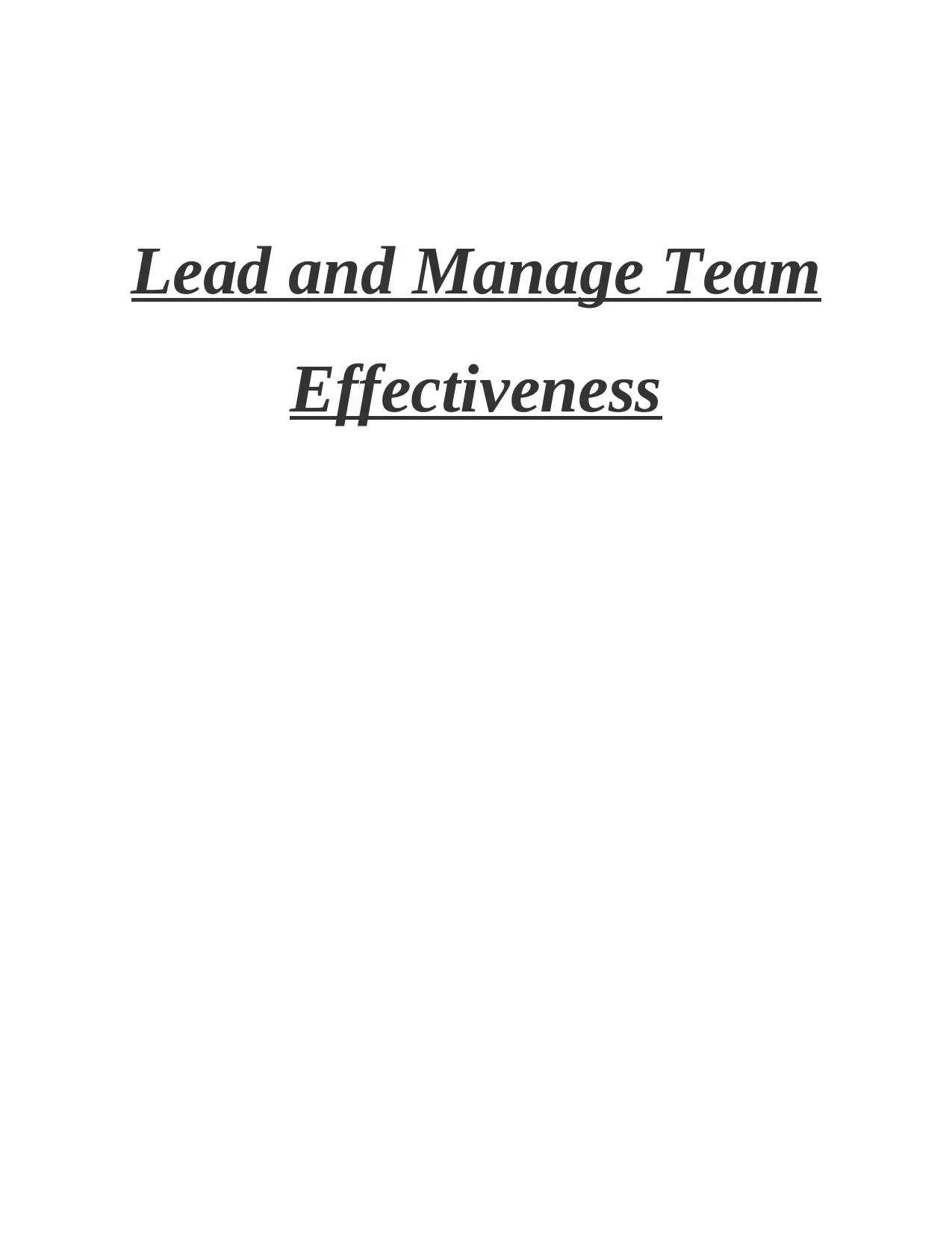
Lead and Manage Team
Effectiveness
Effectiveness
Paraphrase This Document
Need a fresh take? Get an instant paraphrase of this document with our AI Paraphraser
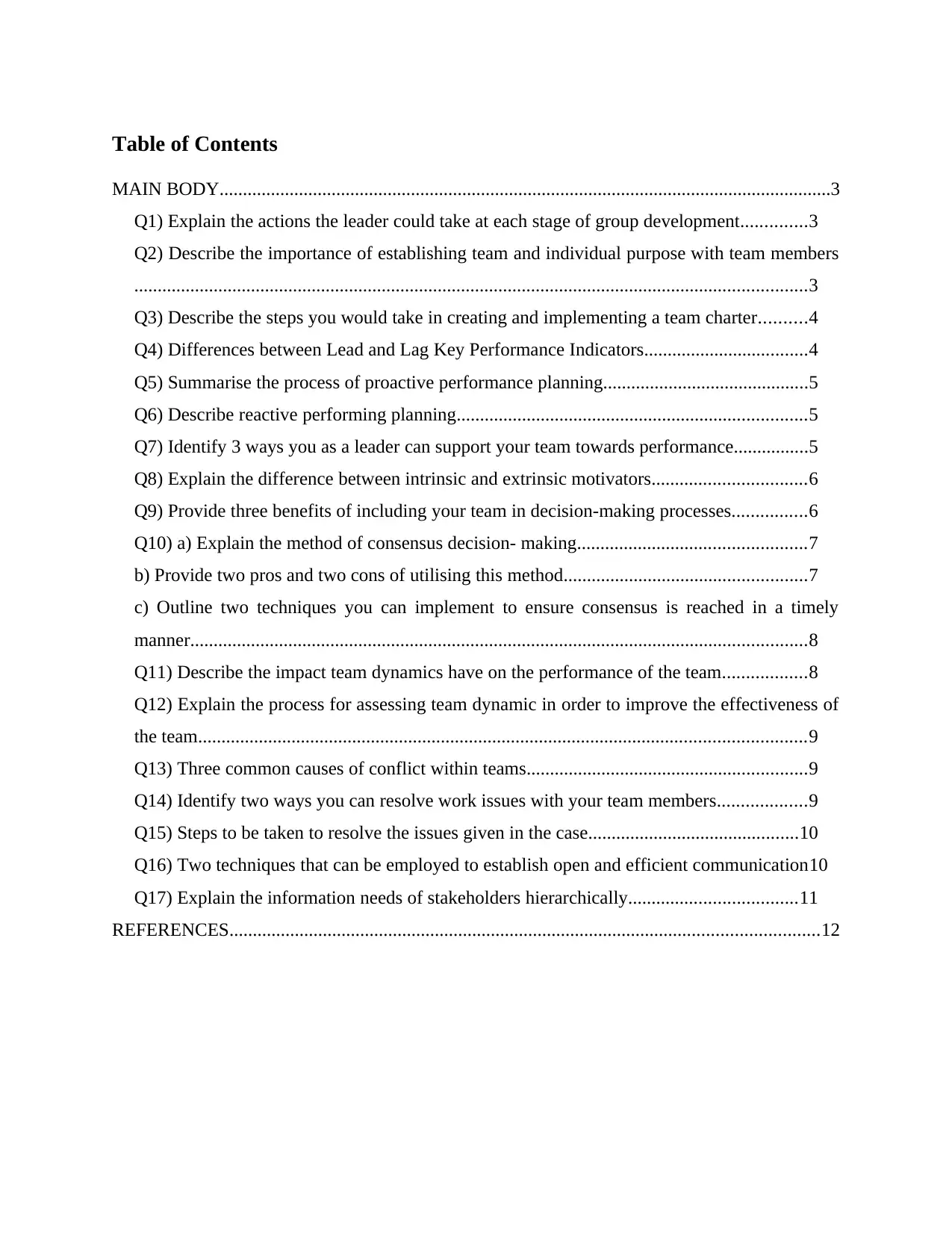
Table of Contents
MAIN BODY...................................................................................................................................3
Q1) Explain the actions the leader could take at each stage of group development..............3
Q2) Describe the importance of establishing team and individual purpose with team members
................................................................................................................................................3
Q3) Describe the steps you would take in creating and implementing a team charter..........4
Q4) Differences between Lead and Lag Key Performance Indicators...................................4
Q5) Summarise the process of proactive performance planning............................................5
Q6) Describe reactive performing planning...........................................................................5
Q7) Identify 3 ways you as a leader can support your team towards performance................5
Q8) Explain the difference between intrinsic and extrinsic motivators.................................6
Q9) Provide three benefits of including your team in decision-making processes................6
Q10) a) Explain the method of consensus decision- making.................................................7
b) Provide two pros and two cons of utilising this method....................................................7
c) Outline two techniques you can implement to ensure consensus is reached in a timely
manner....................................................................................................................................8
Q11) Describe the impact team dynamics have on the performance of the team..................8
Q12) Explain the process for assessing team dynamic in order to improve the effectiveness of
the team..................................................................................................................................9
Q13) Three common causes of conflict within teams............................................................9
Q14) Identify two ways you can resolve work issues with your team members...................9
Q15) Steps to be taken to resolve the issues given in the case.............................................10
Q16) Two techniques that can be employed to establish open and efficient communication10
Q17) Explain the information needs of stakeholders hierarchically....................................11
REFERENCES..............................................................................................................................12
MAIN BODY...................................................................................................................................3
Q1) Explain the actions the leader could take at each stage of group development..............3
Q2) Describe the importance of establishing team and individual purpose with team members
................................................................................................................................................3
Q3) Describe the steps you would take in creating and implementing a team charter..........4
Q4) Differences between Lead and Lag Key Performance Indicators...................................4
Q5) Summarise the process of proactive performance planning............................................5
Q6) Describe reactive performing planning...........................................................................5
Q7) Identify 3 ways you as a leader can support your team towards performance................5
Q8) Explain the difference between intrinsic and extrinsic motivators.................................6
Q9) Provide three benefits of including your team in decision-making processes................6
Q10) a) Explain the method of consensus decision- making.................................................7
b) Provide two pros and two cons of utilising this method....................................................7
c) Outline two techniques you can implement to ensure consensus is reached in a timely
manner....................................................................................................................................8
Q11) Describe the impact team dynamics have on the performance of the team..................8
Q12) Explain the process for assessing team dynamic in order to improve the effectiveness of
the team..................................................................................................................................9
Q13) Three common causes of conflict within teams............................................................9
Q14) Identify two ways you can resolve work issues with your team members...................9
Q15) Steps to be taken to resolve the issues given in the case.............................................10
Q16) Two techniques that can be employed to establish open and efficient communication10
Q17) Explain the information needs of stakeholders hierarchically....................................11
REFERENCES..............................................................................................................................12
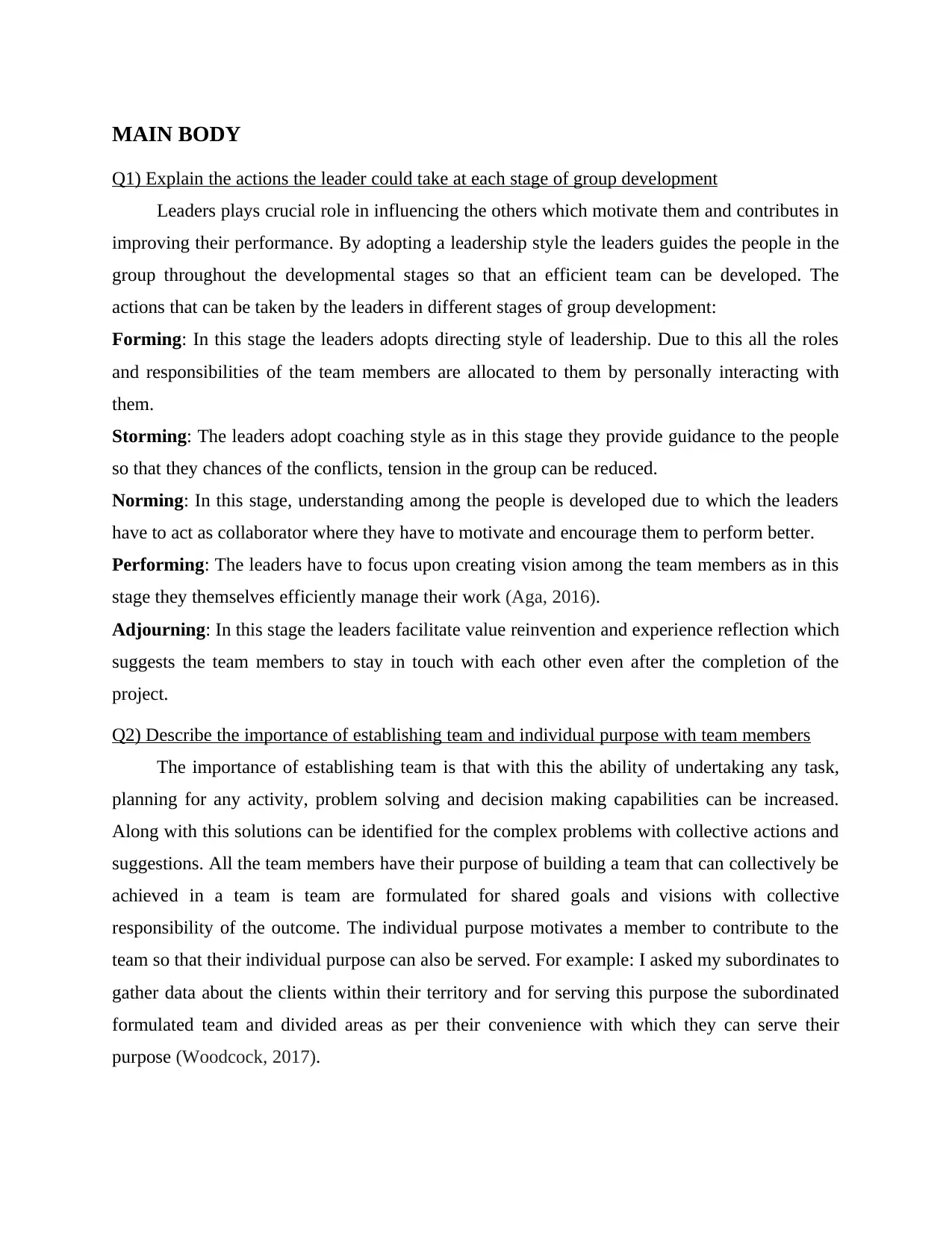
MAIN BODY
Q1) Explain the actions the leader could take at each stage of group development
Leaders plays crucial role in influencing the others which motivate them and contributes in
improving their performance. By adopting a leadership style the leaders guides the people in the
group throughout the developmental stages so that an efficient team can be developed. The
actions that can be taken by the leaders in different stages of group development:
Forming: In this stage the leaders adopts directing style of leadership. Due to this all the roles
and responsibilities of the team members are allocated to them by personally interacting with
them.
Storming: The leaders adopt coaching style as in this stage they provide guidance to the people
so that they chances of the conflicts, tension in the group can be reduced.
Norming: In this stage, understanding among the people is developed due to which the leaders
have to act as collaborator where they have to motivate and encourage them to perform better.
Performing: The leaders have to focus upon creating vision among the team members as in this
stage they themselves efficiently manage their work (Aga, 2016).
Adjourning: In this stage the leaders facilitate value reinvention and experience reflection which
suggests the team members to stay in touch with each other even after the completion of the
project.
Q2) Describe the importance of establishing team and individual purpose with team members
The importance of establishing team is that with this the ability of undertaking any task,
planning for any activity, problem solving and decision making capabilities can be increased.
Along with this solutions can be identified for the complex problems with collective actions and
suggestions. All the team members have their purpose of building a team that can collectively be
achieved in a team is team are formulated for shared goals and visions with collective
responsibility of the outcome. The individual purpose motivates a member to contribute to the
team so that their individual purpose can also be served. For example: I asked my subordinates to
gather data about the clients within their territory and for serving this purpose the subordinated
formulated team and divided areas as per their convenience with which they can serve their
purpose (Woodcock, 2017).
Q1) Explain the actions the leader could take at each stage of group development
Leaders plays crucial role in influencing the others which motivate them and contributes in
improving their performance. By adopting a leadership style the leaders guides the people in the
group throughout the developmental stages so that an efficient team can be developed. The
actions that can be taken by the leaders in different stages of group development:
Forming: In this stage the leaders adopts directing style of leadership. Due to this all the roles
and responsibilities of the team members are allocated to them by personally interacting with
them.
Storming: The leaders adopt coaching style as in this stage they provide guidance to the people
so that they chances of the conflicts, tension in the group can be reduced.
Norming: In this stage, understanding among the people is developed due to which the leaders
have to act as collaborator where they have to motivate and encourage them to perform better.
Performing: The leaders have to focus upon creating vision among the team members as in this
stage they themselves efficiently manage their work (Aga, 2016).
Adjourning: In this stage the leaders facilitate value reinvention and experience reflection which
suggests the team members to stay in touch with each other even after the completion of the
project.
Q2) Describe the importance of establishing team and individual purpose with team members
The importance of establishing team is that with this the ability of undertaking any task,
planning for any activity, problem solving and decision making capabilities can be increased.
Along with this solutions can be identified for the complex problems with collective actions and
suggestions. All the team members have their purpose of building a team that can collectively be
achieved in a team is team are formulated for shared goals and visions with collective
responsibility of the outcome. The individual purpose motivates a member to contribute to the
team so that their individual purpose can also be served. For example: I asked my subordinates to
gather data about the clients within their territory and for serving this purpose the subordinated
formulated team and divided areas as per their convenience with which they can serve their
purpose (Woodcock, 2017).
⊘ This is a preview!⊘
Do you want full access?
Subscribe today to unlock all pages.

Trusted by 1+ million students worldwide
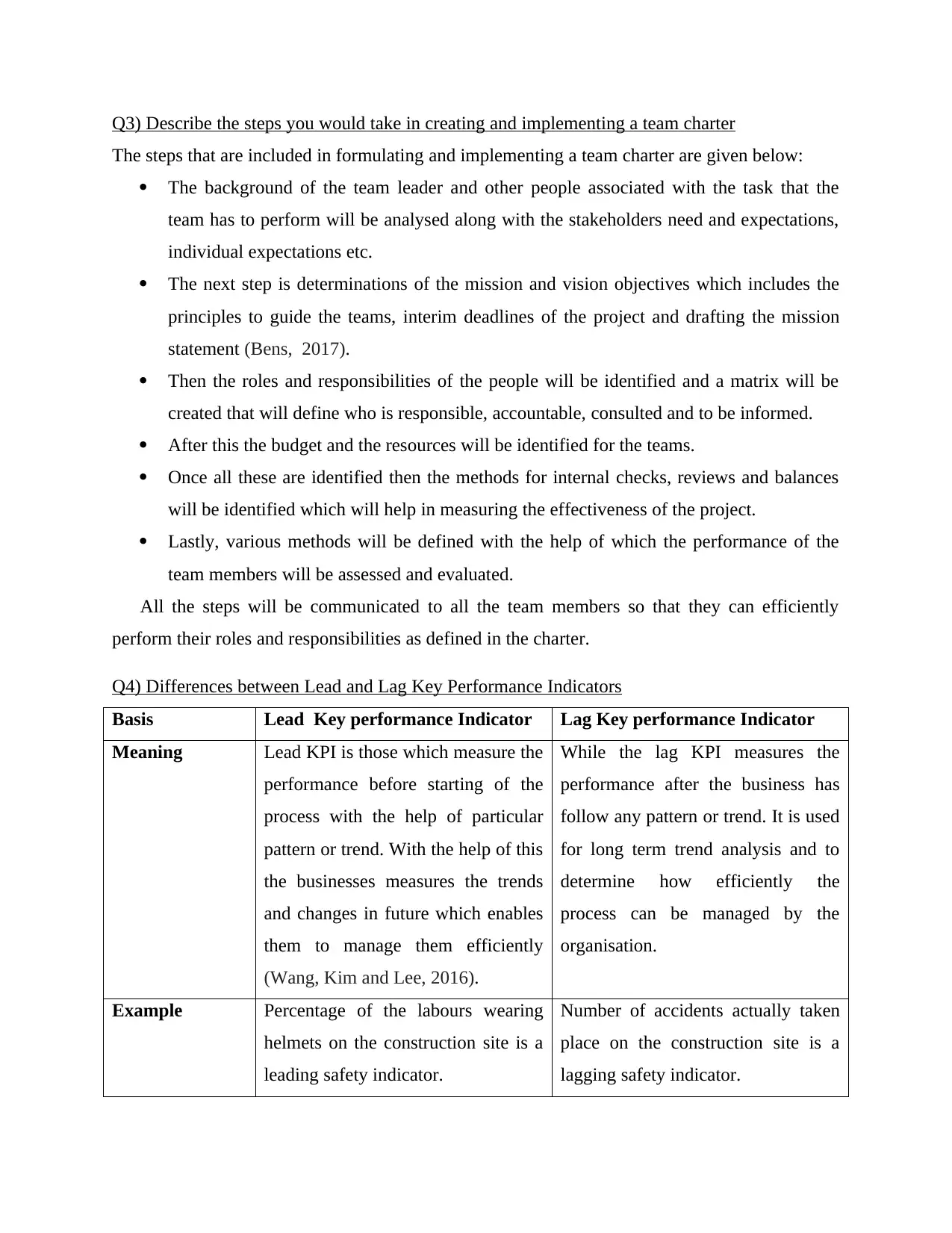
Q3) Describe the steps you would take in creating and implementing a team charter
The steps that are included in formulating and implementing a team charter are given below:
The background of the team leader and other people associated with the task that the
team has to perform will be analysed along with the stakeholders need and expectations,
individual expectations etc.
The next step is determinations of the mission and vision objectives which includes the
principles to guide the teams, interim deadlines of the project and drafting the mission
statement (Bens, 2017).
Then the roles and responsibilities of the people will be identified and a matrix will be
created that will define who is responsible, accountable, consulted and to be informed.
After this the budget and the resources will be identified for the teams.
Once all these are identified then the methods for internal checks, reviews and balances
will be identified which will help in measuring the effectiveness of the project.
Lastly, various methods will be defined with the help of which the performance of the
team members will be assessed and evaluated.
All the steps will be communicated to all the team members so that they can efficiently
perform their roles and responsibilities as defined in the charter.
Q4) Differences between Lead and Lag Key Performance Indicators
Basis Lead Key performance Indicator Lag Key performance Indicator
Meaning Lead KPI is those which measure the
performance before starting of the
process with the help of particular
pattern or trend. With the help of this
the businesses measures the trends
and changes in future which enables
them to manage them efficiently
(Wang, Kim and Lee, 2016).
While the lag KPI measures the
performance after the business has
follow any pattern or trend. It is used
for long term trend analysis and to
determine how efficiently the
process can be managed by the
organisation.
Example Percentage of the labours wearing
helmets on the construction site is a
leading safety indicator.
Number of accidents actually taken
place on the construction site is a
lagging safety indicator.
The steps that are included in formulating and implementing a team charter are given below:
The background of the team leader and other people associated with the task that the
team has to perform will be analysed along with the stakeholders need and expectations,
individual expectations etc.
The next step is determinations of the mission and vision objectives which includes the
principles to guide the teams, interim deadlines of the project and drafting the mission
statement (Bens, 2017).
Then the roles and responsibilities of the people will be identified and a matrix will be
created that will define who is responsible, accountable, consulted and to be informed.
After this the budget and the resources will be identified for the teams.
Once all these are identified then the methods for internal checks, reviews and balances
will be identified which will help in measuring the effectiveness of the project.
Lastly, various methods will be defined with the help of which the performance of the
team members will be assessed and evaluated.
All the steps will be communicated to all the team members so that they can efficiently
perform their roles and responsibilities as defined in the charter.
Q4) Differences between Lead and Lag Key Performance Indicators
Basis Lead Key performance Indicator Lag Key performance Indicator
Meaning Lead KPI is those which measure the
performance before starting of the
process with the help of particular
pattern or trend. With the help of this
the businesses measures the trends
and changes in future which enables
them to manage them efficiently
(Wang, Kim and Lee, 2016).
While the lag KPI measures the
performance after the business has
follow any pattern or trend. It is used
for long term trend analysis and to
determine how efficiently the
process can be managed by the
organisation.
Example Percentage of the labours wearing
helmets on the construction site is a
leading safety indicator.
Number of accidents actually taken
place on the construction site is a
lagging safety indicator.
Paraphrase This Document
Need a fresh take? Get an instant paraphrase of this document with our AI Paraphraser
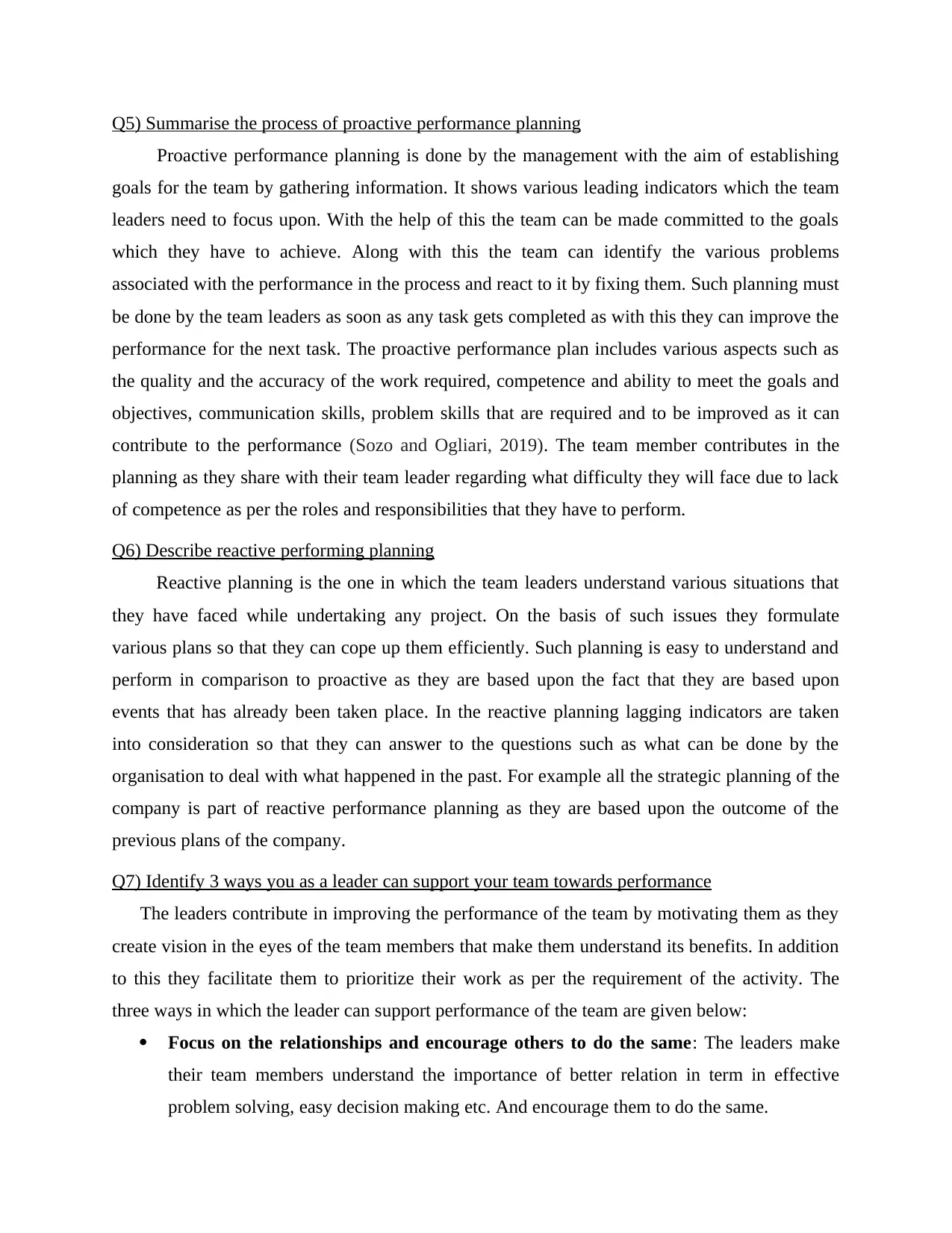
Q5) Summarise the process of proactive performance planning
Proactive performance planning is done by the management with the aim of establishing
goals for the team by gathering information. It shows various leading indicators which the team
leaders need to focus upon. With the help of this the team can be made committed to the goals
which they have to achieve. Along with this the team can identify the various problems
associated with the performance in the process and react to it by fixing them. Such planning must
be done by the team leaders as soon as any task gets completed as with this they can improve the
performance for the next task. The proactive performance plan includes various aspects such as
the quality and the accuracy of the work required, competence and ability to meet the goals and
objectives, communication skills, problem skills that are required and to be improved as it can
contribute to the performance (Sozo and Ogliari, 2019). The team member contributes in the
planning as they share with their team leader regarding what difficulty they will face due to lack
of competence as per the roles and responsibilities that they have to perform.
Q6) Describe reactive performing planning
Reactive planning is the one in which the team leaders understand various situations that
they have faced while undertaking any project. On the basis of such issues they formulate
various plans so that they can cope up them efficiently. Such planning is easy to understand and
perform in comparison to proactive as they are based upon the fact that they are based upon
events that has already been taken place. In the reactive planning lagging indicators are taken
into consideration so that they can answer to the questions such as what can be done by the
organisation to deal with what happened in the past. For example all the strategic planning of the
company is part of reactive performance planning as they are based upon the outcome of the
previous plans of the company.
Q7) Identify 3 ways you as a leader can support your team towards performance
The leaders contribute in improving the performance of the team by motivating them as they
create vision in the eyes of the team members that make them understand its benefits. In addition
to this they facilitate them to prioritize their work as per the requirement of the activity. The
three ways in which the leader can support performance of the team are given below:
Focus on the relationships and encourage others to do the same: The leaders make
their team members understand the importance of better relation in term in effective
problem solving, easy decision making etc. And encourage them to do the same.
Proactive performance planning is done by the management with the aim of establishing
goals for the team by gathering information. It shows various leading indicators which the team
leaders need to focus upon. With the help of this the team can be made committed to the goals
which they have to achieve. Along with this the team can identify the various problems
associated with the performance in the process and react to it by fixing them. Such planning must
be done by the team leaders as soon as any task gets completed as with this they can improve the
performance for the next task. The proactive performance plan includes various aspects such as
the quality and the accuracy of the work required, competence and ability to meet the goals and
objectives, communication skills, problem skills that are required and to be improved as it can
contribute to the performance (Sozo and Ogliari, 2019). The team member contributes in the
planning as they share with their team leader regarding what difficulty they will face due to lack
of competence as per the roles and responsibilities that they have to perform.
Q6) Describe reactive performing planning
Reactive planning is the one in which the team leaders understand various situations that
they have faced while undertaking any project. On the basis of such issues they formulate
various plans so that they can cope up them efficiently. Such planning is easy to understand and
perform in comparison to proactive as they are based upon the fact that they are based upon
events that has already been taken place. In the reactive planning lagging indicators are taken
into consideration so that they can answer to the questions such as what can be done by the
organisation to deal with what happened in the past. For example all the strategic planning of the
company is part of reactive performance planning as they are based upon the outcome of the
previous plans of the company.
Q7) Identify 3 ways you as a leader can support your team towards performance
The leaders contribute in improving the performance of the team by motivating them as they
create vision in the eyes of the team members that make them understand its benefits. In addition
to this they facilitate them to prioritize their work as per the requirement of the activity. The
three ways in which the leader can support performance of the team are given below:
Focus on the relationships and encourage others to do the same: The leaders make
their team members understand the importance of better relation in term in effective
problem solving, easy decision making etc. And encourage them to do the same.
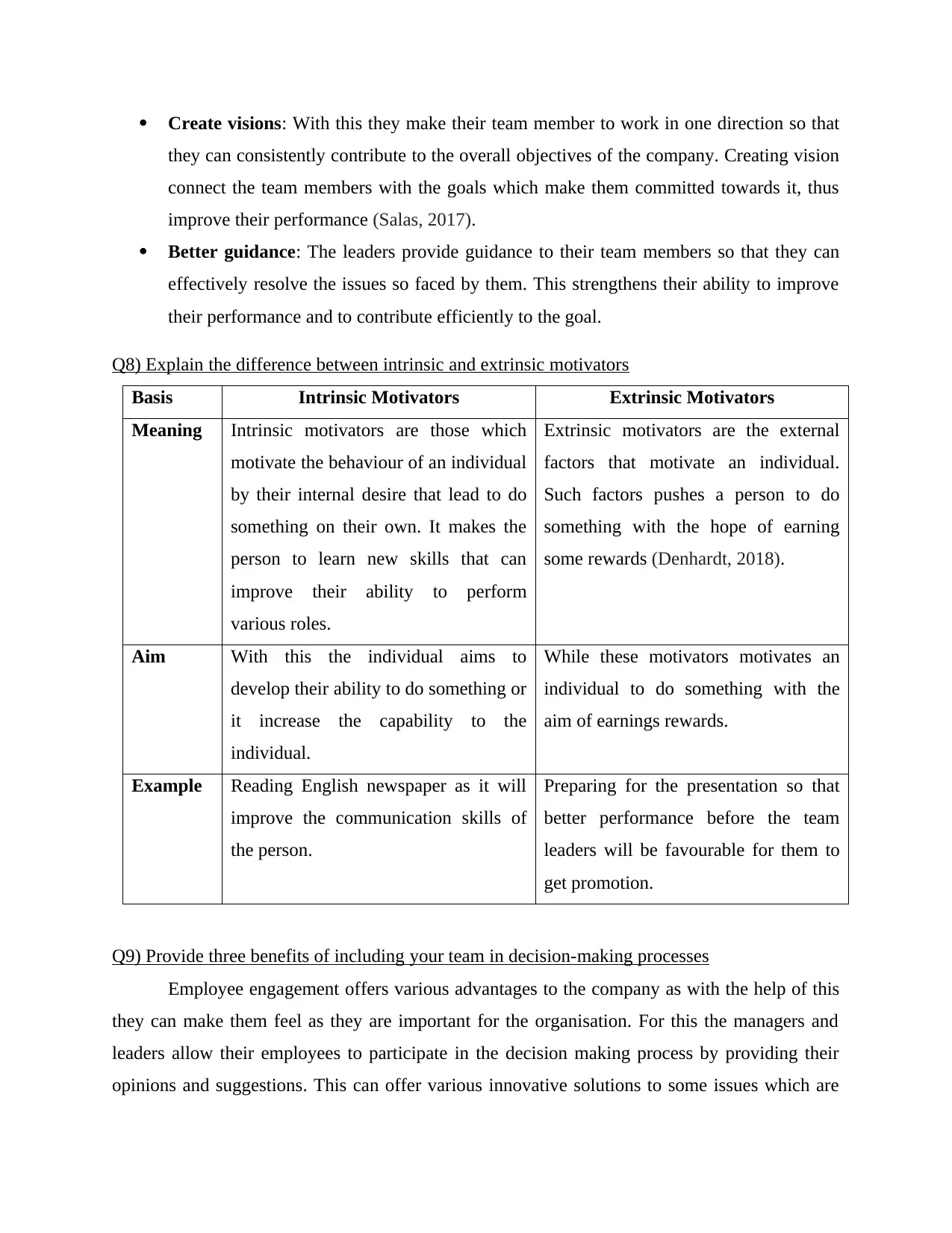
Create visions: With this they make their team member to work in one direction so that
they can consistently contribute to the overall objectives of the company. Creating vision
connect the team members with the goals which make them committed towards it, thus
improve their performance (Salas, 2017).
Better guidance: The leaders provide guidance to their team members so that they can
effectively resolve the issues so faced by them. This strengthens their ability to improve
their performance and to contribute efficiently to the goal.
Q8) Explain the difference between intrinsic and extrinsic motivators
Basis Intrinsic Motivators Extrinsic Motivators
Meaning Intrinsic motivators are those which
motivate the behaviour of an individual
by their internal desire that lead to do
something on their own. It makes the
person to learn new skills that can
improve their ability to perform
various roles.
Extrinsic motivators are the external
factors that motivate an individual.
Such factors pushes a person to do
something with the hope of earning
some rewards (Denhardt, 2018).
Aim With this the individual aims to
develop their ability to do something or
it increase the capability to the
individual.
While these motivators motivates an
individual to do something with the
aim of earnings rewards.
Example Reading English newspaper as it will
improve the communication skills of
the person.
Preparing for the presentation so that
better performance before the team
leaders will be favourable for them to
get promotion.
Q9) Provide three benefits of including your team in decision-making processes
Employee engagement offers various advantages to the company as with the help of this
they can make them feel as they are important for the organisation. For this the managers and
leaders allow their employees to participate in the decision making process by providing their
opinions and suggestions. This can offer various innovative solutions to some issues which are
they can consistently contribute to the overall objectives of the company. Creating vision
connect the team members with the goals which make them committed towards it, thus
improve their performance (Salas, 2017).
Better guidance: The leaders provide guidance to their team members so that they can
effectively resolve the issues so faced by them. This strengthens their ability to improve
their performance and to contribute efficiently to the goal.
Q8) Explain the difference between intrinsic and extrinsic motivators
Basis Intrinsic Motivators Extrinsic Motivators
Meaning Intrinsic motivators are those which
motivate the behaviour of an individual
by their internal desire that lead to do
something on their own. It makes the
person to learn new skills that can
improve their ability to perform
various roles.
Extrinsic motivators are the external
factors that motivate an individual.
Such factors pushes a person to do
something with the hope of earning
some rewards (Denhardt, 2018).
Aim With this the individual aims to
develop their ability to do something or
it increase the capability to the
individual.
While these motivators motivates an
individual to do something with the
aim of earnings rewards.
Example Reading English newspaper as it will
improve the communication skills of
the person.
Preparing for the presentation so that
better performance before the team
leaders will be favourable for them to
get promotion.
Q9) Provide three benefits of including your team in decision-making processes
Employee engagement offers various advantages to the company as with the help of this
they can make them feel as they are important for the organisation. For this the managers and
leaders allow their employees to participate in the decision making process by providing their
opinions and suggestions. This can offer various innovative solutions to some issues which are
⊘ This is a preview!⊘
Do you want full access?
Subscribe today to unlock all pages.

Trusted by 1+ million students worldwide
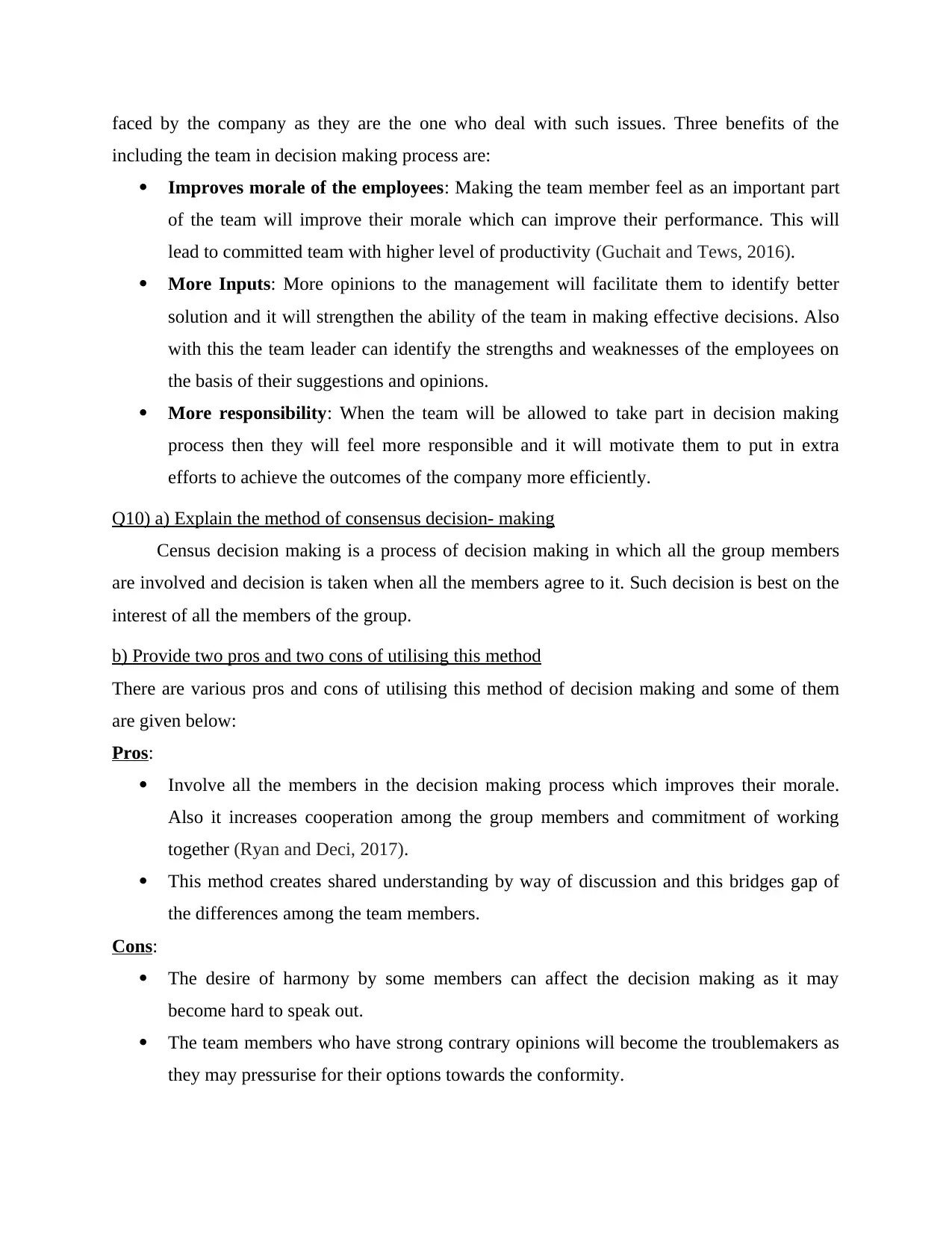
faced by the company as they are the one who deal with such issues. Three benefits of the
including the team in decision making process are:
Improves morale of the employees: Making the team member feel as an important part
of the team will improve their morale which can improve their performance. This will
lead to committed team with higher level of productivity (Guchait and Tews, 2016).
More Inputs: More opinions to the management will facilitate them to identify better
solution and it will strengthen the ability of the team in making effective decisions. Also
with this the team leader can identify the strengths and weaknesses of the employees on
the basis of their suggestions and opinions.
More responsibility: When the team will be allowed to take part in decision making
process then they will feel more responsible and it will motivate them to put in extra
efforts to achieve the outcomes of the company more efficiently.
Q10) a) Explain the method of consensus decision- making
Census decision making is a process of decision making in which all the group members
are involved and decision is taken when all the members agree to it. Such decision is best on the
interest of all the members of the group.
b) Provide two pros and two cons of utilising this method
There are various pros and cons of utilising this method of decision making and some of them
are given below:
Pros:
Involve all the members in the decision making process which improves their morale.
Also it increases cooperation among the group members and commitment of working
together (Ryan and Deci, 2017).
This method creates shared understanding by way of discussion and this bridges gap of
the differences among the team members.
Cons:
The desire of harmony by some members can affect the decision making as it may
become hard to speak out.
The team members who have strong contrary opinions will become the troublemakers as
they may pressurise for their options towards the conformity.
including the team in decision making process are:
Improves morale of the employees: Making the team member feel as an important part
of the team will improve their morale which can improve their performance. This will
lead to committed team with higher level of productivity (Guchait and Tews, 2016).
More Inputs: More opinions to the management will facilitate them to identify better
solution and it will strengthen the ability of the team in making effective decisions. Also
with this the team leader can identify the strengths and weaknesses of the employees on
the basis of their suggestions and opinions.
More responsibility: When the team will be allowed to take part in decision making
process then they will feel more responsible and it will motivate them to put in extra
efforts to achieve the outcomes of the company more efficiently.
Q10) a) Explain the method of consensus decision- making
Census decision making is a process of decision making in which all the group members
are involved and decision is taken when all the members agree to it. Such decision is best on the
interest of all the members of the group.
b) Provide two pros and two cons of utilising this method
There are various pros and cons of utilising this method of decision making and some of them
are given below:
Pros:
Involve all the members in the decision making process which improves their morale.
Also it increases cooperation among the group members and commitment of working
together (Ryan and Deci, 2017).
This method creates shared understanding by way of discussion and this bridges gap of
the differences among the team members.
Cons:
The desire of harmony by some members can affect the decision making as it may
become hard to speak out.
The team members who have strong contrary opinions will become the troublemakers as
they may pressurise for their options towards the conformity.
Paraphrase This Document
Need a fresh take? Get an instant paraphrase of this document with our AI Paraphraser
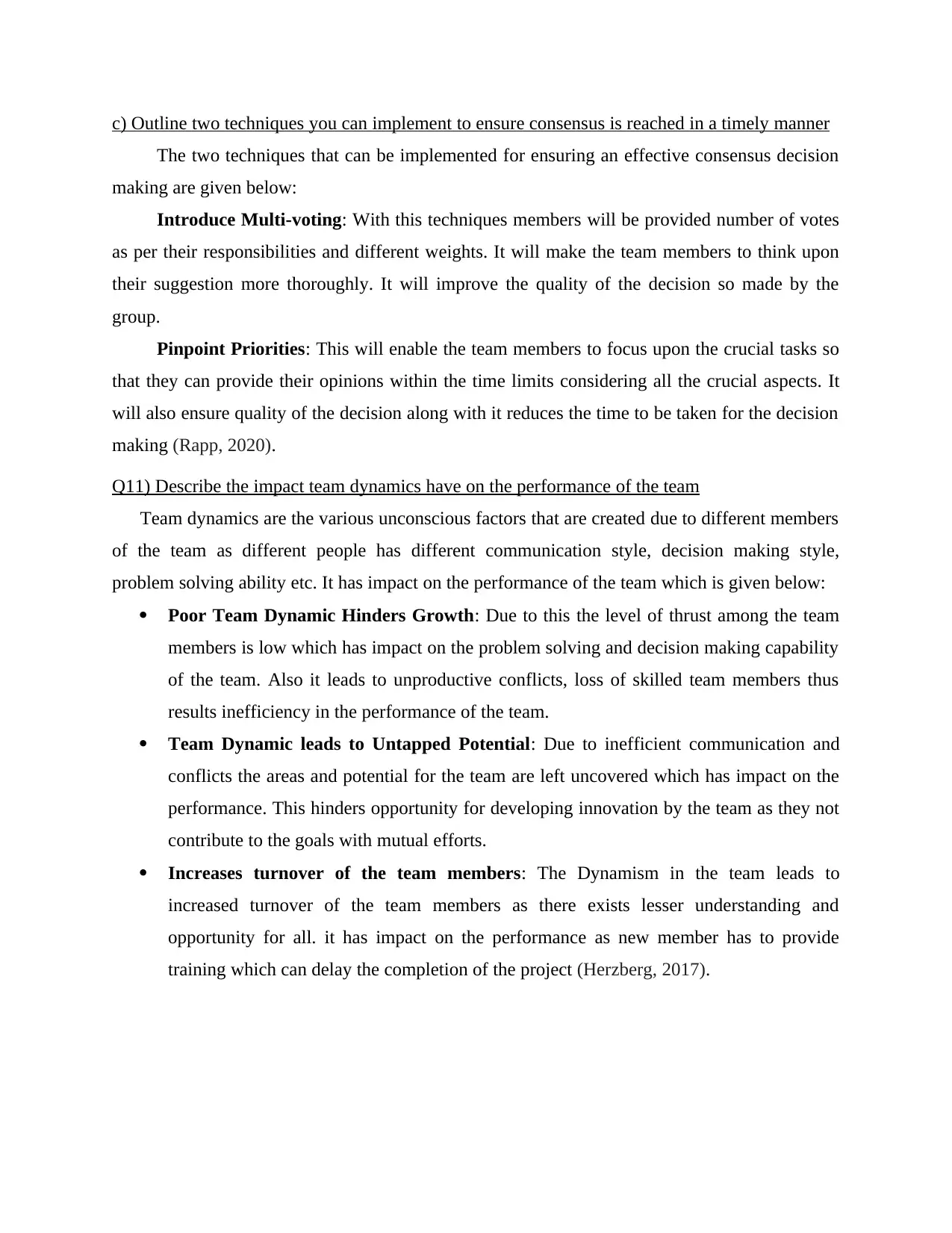
c) Outline two techniques you can implement to ensure consensus is reached in a timely manner
The two techniques that can be implemented for ensuring an effective consensus decision
making are given below:
Introduce Multi-voting: With this techniques members will be provided number of votes
as per their responsibilities and different weights. It will make the team members to think upon
their suggestion more thoroughly. It will improve the quality of the decision so made by the
group.
Pinpoint Priorities: This will enable the team members to focus upon the crucial tasks so
that they can provide their opinions within the time limits considering all the crucial aspects. It
will also ensure quality of the decision along with it reduces the time to be taken for the decision
making (Rapp, 2020).
Q11) Describe the impact team dynamics have on the performance of the team
Team dynamics are the various unconscious factors that are created due to different members
of the team as different people has different communication style, decision making style,
problem solving ability etc. It has impact on the performance of the team which is given below:
Poor Team Dynamic Hinders Growth: Due to this the level of thrust among the team
members is low which has impact on the problem solving and decision making capability
of the team. Also it leads to unproductive conflicts, loss of skilled team members thus
results inefficiency in the performance of the team.
Team Dynamic leads to Untapped Potential: Due to inefficient communication and
conflicts the areas and potential for the team are left uncovered which has impact on the
performance. This hinders opportunity for developing innovation by the team as they not
contribute to the goals with mutual efforts.
Increases turnover of the team members: The Dynamism in the team leads to
increased turnover of the team members as there exists lesser understanding and
opportunity for all. it has impact on the performance as new member has to provide
training which can delay the completion of the project (Herzberg, 2017).
The two techniques that can be implemented for ensuring an effective consensus decision
making are given below:
Introduce Multi-voting: With this techniques members will be provided number of votes
as per their responsibilities and different weights. It will make the team members to think upon
their suggestion more thoroughly. It will improve the quality of the decision so made by the
group.
Pinpoint Priorities: This will enable the team members to focus upon the crucial tasks so
that they can provide their opinions within the time limits considering all the crucial aspects. It
will also ensure quality of the decision along with it reduces the time to be taken for the decision
making (Rapp, 2020).
Q11) Describe the impact team dynamics have on the performance of the team
Team dynamics are the various unconscious factors that are created due to different members
of the team as different people has different communication style, decision making style,
problem solving ability etc. It has impact on the performance of the team which is given below:
Poor Team Dynamic Hinders Growth: Due to this the level of thrust among the team
members is low which has impact on the problem solving and decision making capability
of the team. Also it leads to unproductive conflicts, loss of skilled team members thus
results inefficiency in the performance of the team.
Team Dynamic leads to Untapped Potential: Due to inefficient communication and
conflicts the areas and potential for the team are left uncovered which has impact on the
performance. This hinders opportunity for developing innovation by the team as they not
contribute to the goals with mutual efforts.
Increases turnover of the team members: The Dynamism in the team leads to
increased turnover of the team members as there exists lesser understanding and
opportunity for all. it has impact on the performance as new member has to provide
training which can delay the completion of the project (Herzberg, 2017).
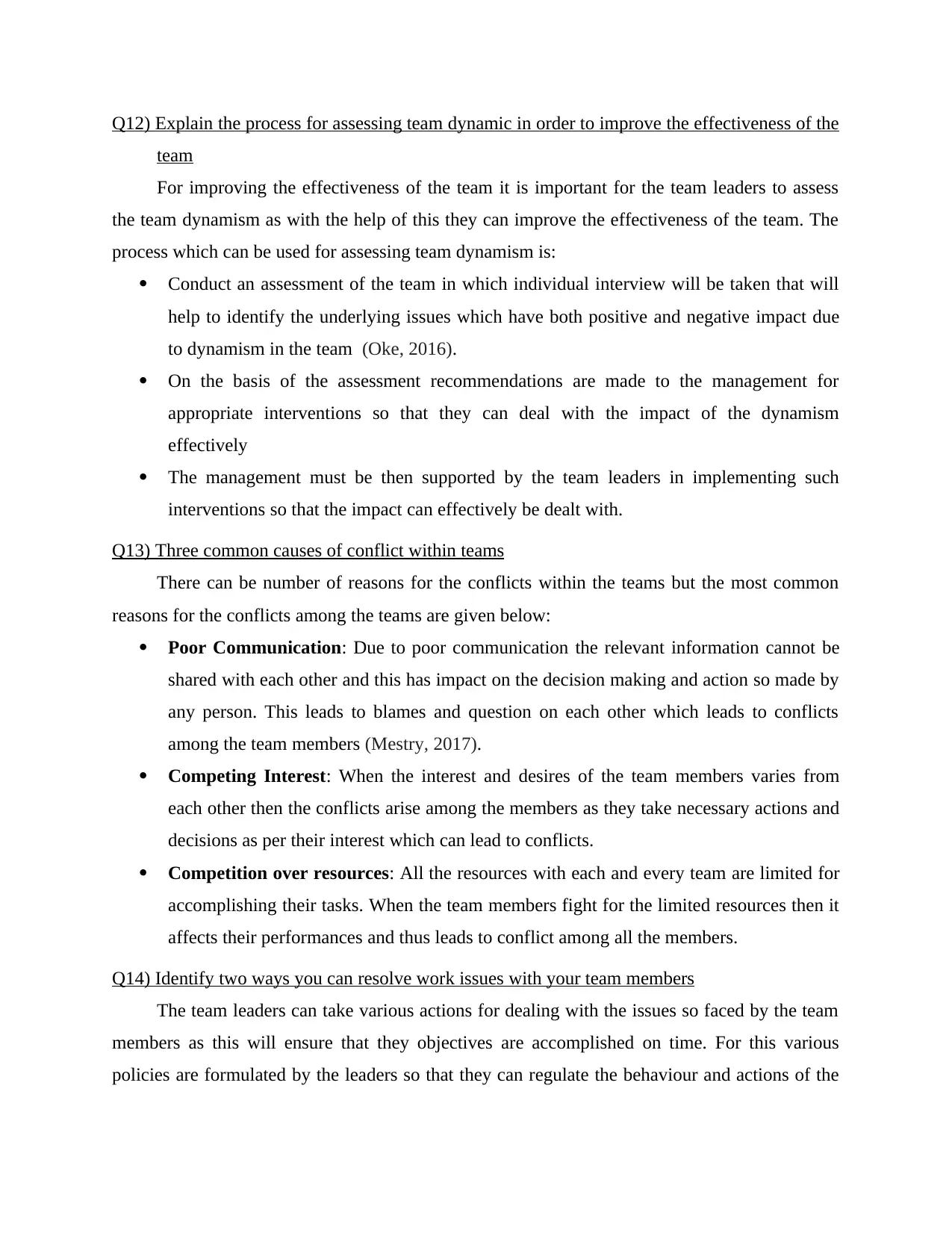
Q12) Explain the process for assessing team dynamic in order to improve the effectiveness of the
team
For improving the effectiveness of the team it is important for the team leaders to assess
the team dynamism as with the help of this they can improve the effectiveness of the team. The
process which can be used for assessing team dynamism is:
Conduct an assessment of the team in which individual interview will be taken that will
help to identify the underlying issues which have both positive and negative impact due
to dynamism in the team (Oke, 2016).
On the basis of the assessment recommendations are made to the management for
appropriate interventions so that they can deal with the impact of the dynamism
effectively
The management must be then supported by the team leaders in implementing such
interventions so that the impact can effectively be dealt with.
Q13) Three common causes of conflict within teams
There can be number of reasons for the conflicts within the teams but the most common
reasons for the conflicts among the teams are given below:
Poor Communication: Due to poor communication the relevant information cannot be
shared with each other and this has impact on the decision making and action so made by
any person. This leads to blames and question on each other which leads to conflicts
among the team members (Mestry, 2017).
Competing Interest: When the interest and desires of the team members varies from
each other then the conflicts arise among the members as they take necessary actions and
decisions as per their interest which can lead to conflicts.
Competition over resources: All the resources with each and every team are limited for
accomplishing their tasks. When the team members fight for the limited resources then it
affects their performances and thus leads to conflict among all the members.
Q14) Identify two ways you can resolve work issues with your team members
The team leaders can take various actions for dealing with the issues so faced by the team
members as this will ensure that they objectives are accomplished on time. For this various
policies are formulated by the leaders so that they can regulate the behaviour and actions of the
team
For improving the effectiveness of the team it is important for the team leaders to assess
the team dynamism as with the help of this they can improve the effectiveness of the team. The
process which can be used for assessing team dynamism is:
Conduct an assessment of the team in which individual interview will be taken that will
help to identify the underlying issues which have both positive and negative impact due
to dynamism in the team (Oke, 2016).
On the basis of the assessment recommendations are made to the management for
appropriate interventions so that they can deal with the impact of the dynamism
effectively
The management must be then supported by the team leaders in implementing such
interventions so that the impact can effectively be dealt with.
Q13) Three common causes of conflict within teams
There can be number of reasons for the conflicts within the teams but the most common
reasons for the conflicts among the teams are given below:
Poor Communication: Due to poor communication the relevant information cannot be
shared with each other and this has impact on the decision making and action so made by
any person. This leads to blames and question on each other which leads to conflicts
among the team members (Mestry, 2017).
Competing Interest: When the interest and desires of the team members varies from
each other then the conflicts arise among the members as they take necessary actions and
decisions as per their interest which can lead to conflicts.
Competition over resources: All the resources with each and every team are limited for
accomplishing their tasks. When the team members fight for the limited resources then it
affects their performances and thus leads to conflict among all the members.
Q14) Identify two ways you can resolve work issues with your team members
The team leaders can take various actions for dealing with the issues so faced by the team
members as this will ensure that they objectives are accomplished on time. For this various
policies are formulated by the leaders so that they can regulate the behaviour and actions of the
⊘ This is a preview!⊘
Do you want full access?
Subscribe today to unlock all pages.

Trusted by 1+ million students worldwide
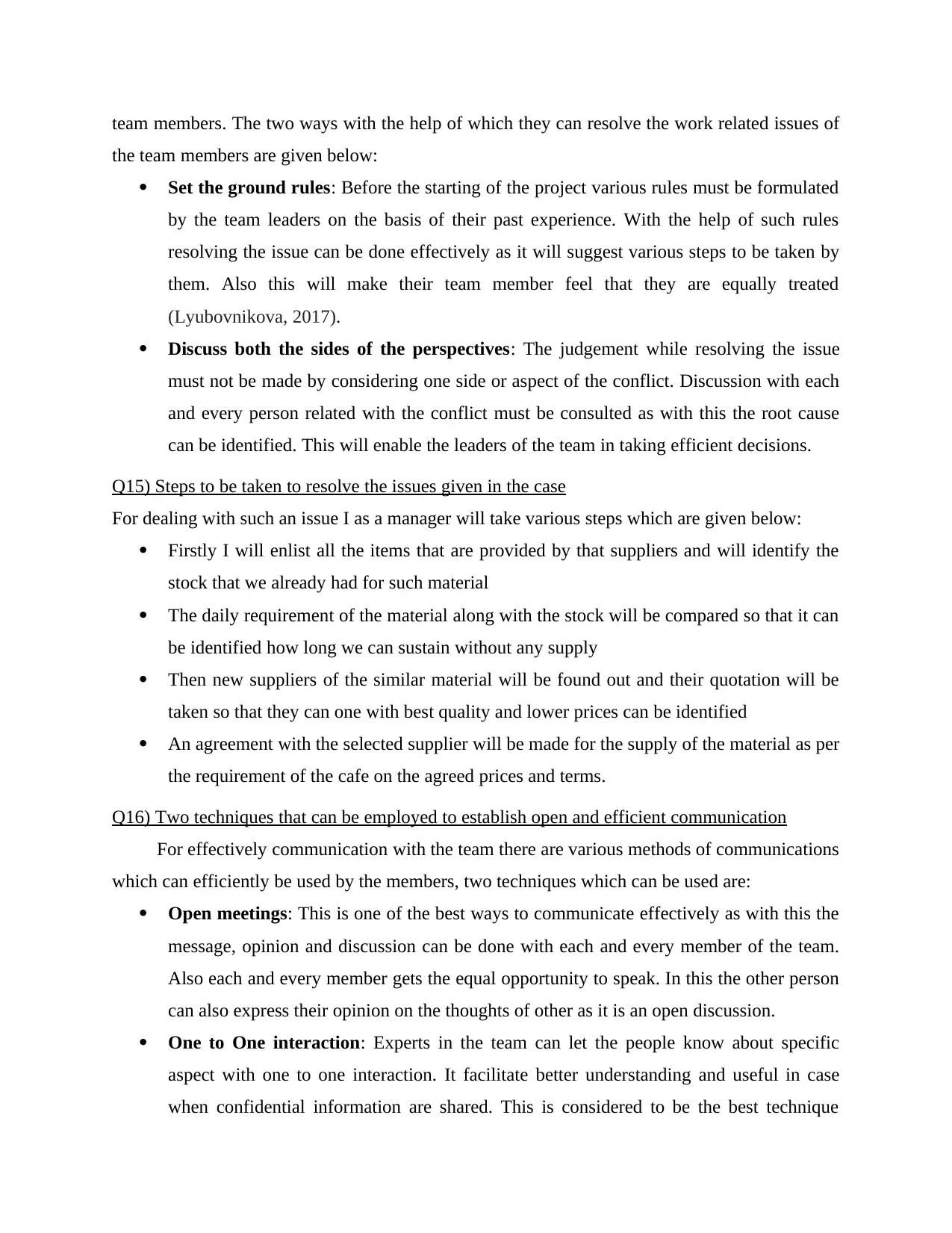
team members. The two ways with the help of which they can resolve the work related issues of
the team members are given below:
Set the ground rules: Before the starting of the project various rules must be formulated
by the team leaders on the basis of their past experience. With the help of such rules
resolving the issue can be done effectively as it will suggest various steps to be taken by
them. Also this will make their team member feel that they are equally treated
(Lyubovnikova, 2017).
Discuss both the sides of the perspectives: The judgement while resolving the issue
must not be made by considering one side or aspect of the conflict. Discussion with each
and every person related with the conflict must be consulted as with this the root cause
can be identified. This will enable the leaders of the team in taking efficient decisions.
Q15) Steps to be taken to resolve the issues given in the case
For dealing with such an issue I as a manager will take various steps which are given below:
Firstly I will enlist all the items that are provided by that suppliers and will identify the
stock that we already had for such material
The daily requirement of the material along with the stock will be compared so that it can
be identified how long we can sustain without any supply
Then new suppliers of the similar material will be found out and their quotation will be
taken so that they can one with best quality and lower prices can be identified
An agreement with the selected supplier will be made for the supply of the material as per
the requirement of the cafe on the agreed prices and terms.
Q16) Two techniques that can be employed to establish open and efficient communication
For effectively communication with the team there are various methods of communications
which can efficiently be used by the members, two techniques which can be used are:
Open meetings: This is one of the best ways to communicate effectively as with this the
message, opinion and discussion can be done with each and every member of the team.
Also each and every member gets the equal opportunity to speak. In this the other person
can also express their opinion on the thoughts of other as it is an open discussion.
One to One interaction: Experts in the team can let the people know about specific
aspect with one to one interaction. It facilitate better understanding and useful in case
when confidential information are shared. This is considered to be the best technique
the team members are given below:
Set the ground rules: Before the starting of the project various rules must be formulated
by the team leaders on the basis of their past experience. With the help of such rules
resolving the issue can be done effectively as it will suggest various steps to be taken by
them. Also this will make their team member feel that they are equally treated
(Lyubovnikova, 2017).
Discuss both the sides of the perspectives: The judgement while resolving the issue
must not be made by considering one side or aspect of the conflict. Discussion with each
and every person related with the conflict must be consulted as with this the root cause
can be identified. This will enable the leaders of the team in taking efficient decisions.
Q15) Steps to be taken to resolve the issues given in the case
For dealing with such an issue I as a manager will take various steps which are given below:
Firstly I will enlist all the items that are provided by that suppliers and will identify the
stock that we already had for such material
The daily requirement of the material along with the stock will be compared so that it can
be identified how long we can sustain without any supply
Then new suppliers of the similar material will be found out and their quotation will be
taken so that they can one with best quality and lower prices can be identified
An agreement with the selected supplier will be made for the supply of the material as per
the requirement of the cafe on the agreed prices and terms.
Q16) Two techniques that can be employed to establish open and efficient communication
For effectively communication with the team there are various methods of communications
which can efficiently be used by the members, two techniques which can be used are:
Open meetings: This is one of the best ways to communicate effectively as with this the
message, opinion and discussion can be done with each and every member of the team.
Also each and every member gets the equal opportunity to speak. In this the other person
can also express their opinion on the thoughts of other as it is an open discussion.
One to One interaction: Experts in the team can let the people know about specific
aspect with one to one interaction. It facilitate better understanding and useful in case
when confidential information are shared. This is considered to be the best technique
Paraphrase This Document
Need a fresh take? Get an instant paraphrase of this document with our AI Paraphraser
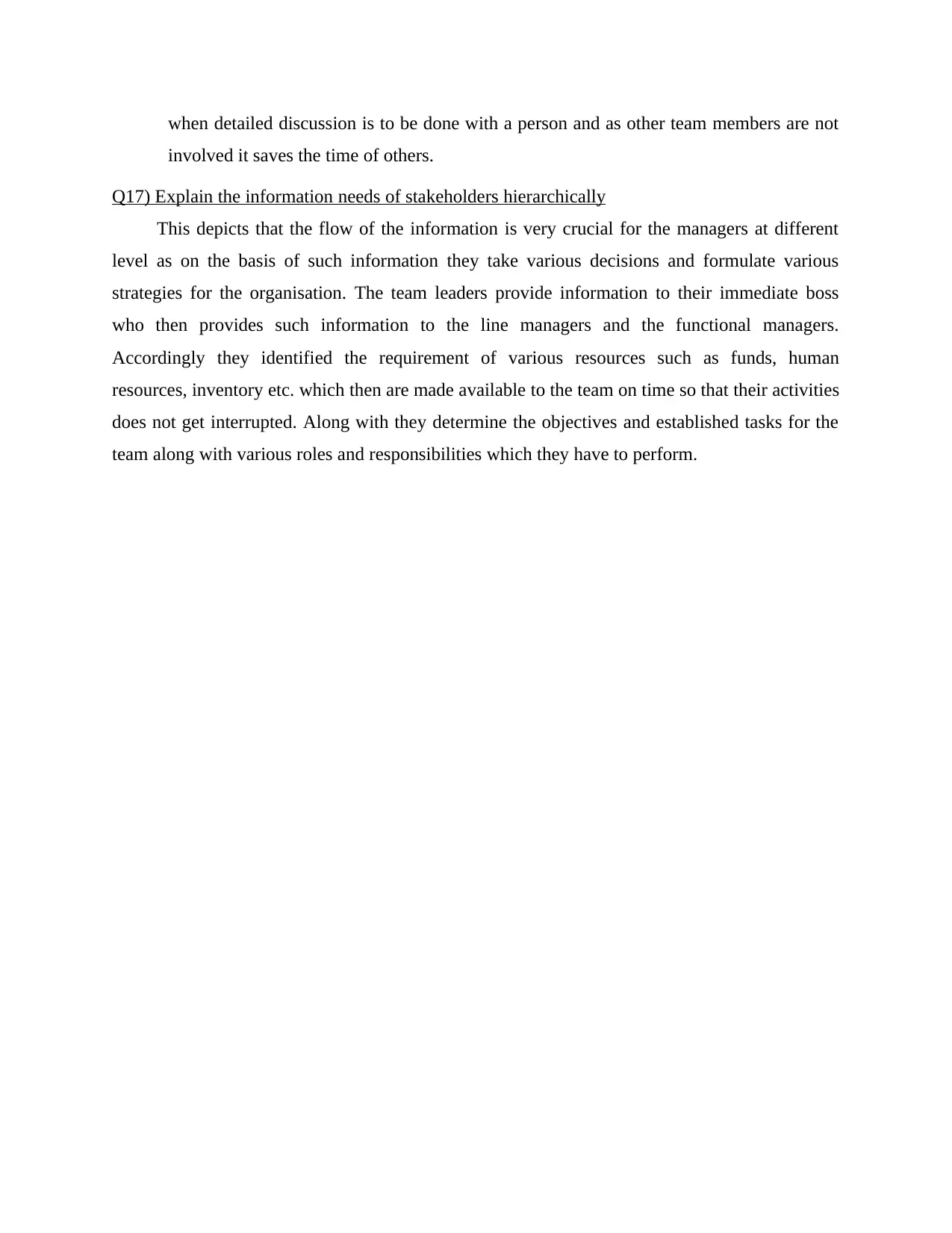
when detailed discussion is to be done with a person and as other team members are not
involved it saves the time of others.
Q17) Explain the information needs of stakeholders hierarchically
This depicts that the flow of the information is very crucial for the managers at different
level as on the basis of such information they take various decisions and formulate various
strategies for the organisation. The team leaders provide information to their immediate boss
who then provides such information to the line managers and the functional managers.
Accordingly they identified the requirement of various resources such as funds, human
resources, inventory etc. which then are made available to the team on time so that their activities
does not get interrupted. Along with they determine the objectives and established tasks for the
team along with various roles and responsibilities which they have to perform.
involved it saves the time of others.
Q17) Explain the information needs of stakeholders hierarchically
This depicts that the flow of the information is very crucial for the managers at different
level as on the basis of such information they take various decisions and formulate various
strategies for the organisation. The team leaders provide information to their immediate boss
who then provides such information to the line managers and the functional managers.
Accordingly they identified the requirement of various resources such as funds, human
resources, inventory etc. which then are made available to the team on time so that their activities
does not get interrupted. Along with they determine the objectives and established tasks for the
team along with various roles and responsibilities which they have to perform.
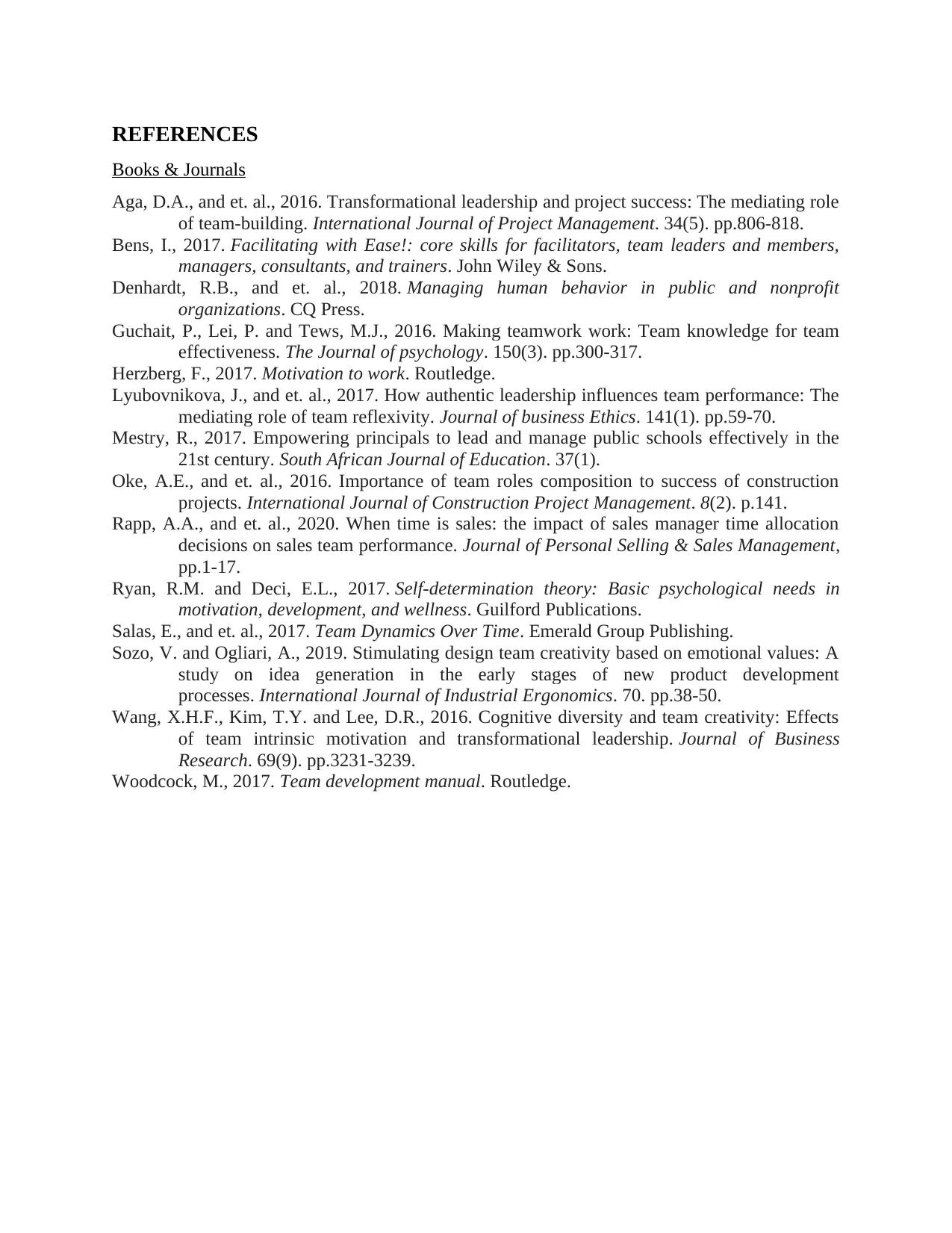
REFERENCES
Books & Journals
Aga, D.A., and et. al., 2016. Transformational leadership and project success: The mediating role
of team-building. International Journal of Project Management. 34(5). pp.806-818.
Bens, I., 2017. Facilitating with Ease!: core skills for facilitators, team leaders and members,
managers, consultants, and trainers. John Wiley & Sons.
Denhardt, R.B., and et. al., 2018. Managing human behavior in public and nonprofit
organizations. CQ Press.
Guchait, P., Lei, P. and Tews, M.J., 2016. Making teamwork work: Team knowledge for team
effectiveness. The Journal of psychology. 150(3). pp.300-317.
Herzberg, F., 2017. Motivation to work. Routledge.
Lyubovnikova, J., and et. al., 2017. How authentic leadership influences team performance: The
mediating role of team reflexivity. Journal of business Ethics. 141(1). pp.59-70.
Mestry, R., 2017. Empowering principals to lead and manage public schools effectively in the
21st century. South African Journal of Education. 37(1).
Oke, A.E., and et. al., 2016. Importance of team roles composition to success of construction
projects. International Journal of Construction Project Management. 8(2). p.141.
Rapp, A.A., and et. al., 2020. When time is sales: the impact of sales manager time allocation
decisions on sales team performance. Journal of Personal Selling & Sales Management,
pp.1-17.
Ryan, R.M. and Deci, E.L., 2017. Self-determination theory: Basic psychological needs in
motivation, development, and wellness. Guilford Publications.
Salas, E., and et. al., 2017. Team Dynamics Over Time. Emerald Group Publishing.
Sozo, V. and Ogliari, A., 2019. Stimulating design team creativity based on emotional values: A
study on idea generation in the early stages of new product development
processes. International Journal of Industrial Ergonomics. 70. pp.38-50.
Wang, X.H.F., Kim, T.Y. and Lee, D.R., 2016. Cognitive diversity and team creativity: Effects
of team intrinsic motivation and transformational leadership. Journal of Business
Research. 69(9). pp.3231-3239.
Woodcock, M., 2017. Team development manual. Routledge.
Books & Journals
Aga, D.A., and et. al., 2016. Transformational leadership and project success: The mediating role
of team-building. International Journal of Project Management. 34(5). pp.806-818.
Bens, I., 2017. Facilitating with Ease!: core skills for facilitators, team leaders and members,
managers, consultants, and trainers. John Wiley & Sons.
Denhardt, R.B., and et. al., 2018. Managing human behavior in public and nonprofit
organizations. CQ Press.
Guchait, P., Lei, P. and Tews, M.J., 2016. Making teamwork work: Team knowledge for team
effectiveness. The Journal of psychology. 150(3). pp.300-317.
Herzberg, F., 2017. Motivation to work. Routledge.
Lyubovnikova, J., and et. al., 2017. How authentic leadership influences team performance: The
mediating role of team reflexivity. Journal of business Ethics. 141(1). pp.59-70.
Mestry, R., 2017. Empowering principals to lead and manage public schools effectively in the
21st century. South African Journal of Education. 37(1).
Oke, A.E., and et. al., 2016. Importance of team roles composition to success of construction
projects. International Journal of Construction Project Management. 8(2). p.141.
Rapp, A.A., and et. al., 2020. When time is sales: the impact of sales manager time allocation
decisions on sales team performance. Journal of Personal Selling & Sales Management,
pp.1-17.
Ryan, R.M. and Deci, E.L., 2017. Self-determination theory: Basic psychological needs in
motivation, development, and wellness. Guilford Publications.
Salas, E., and et. al., 2017. Team Dynamics Over Time. Emerald Group Publishing.
Sozo, V. and Ogliari, A., 2019. Stimulating design team creativity based on emotional values: A
study on idea generation in the early stages of new product development
processes. International Journal of Industrial Ergonomics. 70. pp.38-50.
Wang, X.H.F., Kim, T.Y. and Lee, D.R., 2016. Cognitive diversity and team creativity: Effects
of team intrinsic motivation and transformational leadership. Journal of Business
Research. 69(9). pp.3231-3239.
Woodcock, M., 2017. Team development manual. Routledge.
⊘ This is a preview!⊘
Do you want full access?
Subscribe today to unlock all pages.

Trusted by 1+ million students worldwide
1 out of 12
Related Documents
Your All-in-One AI-Powered Toolkit for Academic Success.
+13062052269
info@desklib.com
Available 24*7 on WhatsApp / Email
![[object Object]](/_next/static/media/star-bottom.7253800d.svg)
Unlock your academic potential
Copyright © 2020–2025 A2Z Services. All Rights Reserved. Developed and managed by ZUCOL.





